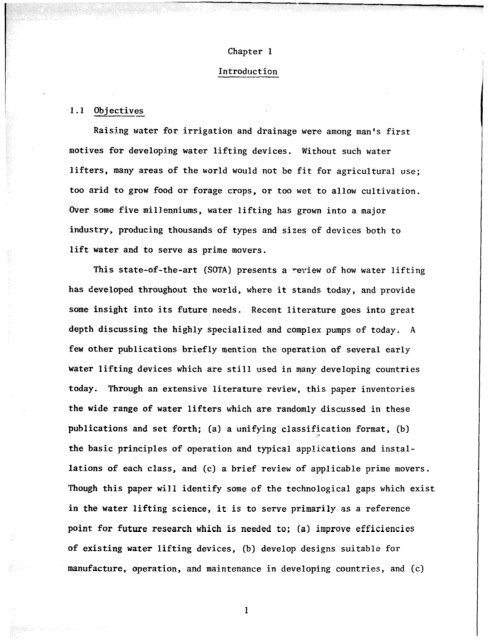MICROFICHE REFERENCE LIBFUUW - Cd3wd.com
MICROFICHE REFERENCE LIBFUUW - Cd3wd.com MICROFICHE REFERENCE LIBFUUW - Cd3wd.com
LIST OF TABLESTable2.12.2a2.2b3.13.23.33.43.53.63.73.83.94.15.15.25.35.45.55.6Criteria for classifying water lifters. ...........Classification of water lifters and ;)umps--positivedisplacement methods. ...................Classification of water lifters and pumps--kinetic methods. .Shadouf performance .....................Manually-operated paddle-wheel performance. .........Records some of the performance data availablechain pump. ........................Persian wheel performance ..................Zawafa performance. .....................Tympanum performance. ....................Screw performance ......................Ram performance ........................Solar pump performance. ...................Typical rotodynamic pump installations. ...........Manual power applications ..................Animal power applications ..................Typical windmill applications ................Typical watermill applications. ...............on thePageTypical electric motor efficiencies and prices. ....... 148Typical energy values and performance of fuels. ....... 150131516406872757684869499111124127137139vi
Chapter 1Introduct ion.l .l Objectives -Raising water for irrigation and drainage were among man’s firstmotives for developing water lifting devices. Without such waterlifters, many areas of the world would not be fit for agricultural use;too arid to grow food or forage crops, or too wet to allow cultivation.Over some five millenniums, water lifting has grown into a majorindustry, producing thousands of types and sizes of devices both toliftwater and to serve as prime movers.This state-of-the-art (SOTA) presents a *eview of how water liftinghas developed throughout the world, where it stands today, and providesome insight into its future needs. Recent literature goes into greatdepth discussing the highly specialized and complex pumps of today. Afew other publications briefly mention the operation of several earlywater lifting devices which are still used in many developing countriestoday. Through an extensive literature review, this paper inventoriesthe wide range of water lifters which are randomly discussed in thesepublications and set forth; (a) a unifying classification format, (b),n.the basic principles of operation and typical applications and instal-lations of each class, and (c) a brief review of applicable prime movers.Though this paper will identify some of the technological gaps which existin the water lifting science, it is to serve primarily as a referencepoint for future research which is needed to; (a) improve efficienciesof existing water lifting devices, (b) develop designs suitable formanufacture, operation, and maintenance in developing countries, an.d (c)1
- Page 1: MICROFICHEREFERENCELIBFUUWA project
- Page 4 and 5: TABLE OF CONTENTS:.LIST OF FIGURES
- Page 6 and 7: LIST OF FIGURES (CONT)Figure3.163.1
- Page 10 and 11: 2find both new water lifting device
- Page 12 and 13: 4During the 3rd centuryB.C., Archim
- Page 14 and 15: GIn 1698, Thomas Savery obtained a
- Page 16 and 17: 9the United States was starting set
- Page 18 and 19: 11engines, motors, transmissions, e
- Page 20 and 21: Chapter 2Water LiftingPrinciples2.1
- Page 22 and 23: 15Table 2.2a Classification of wate
- Page 24 and 25: 2.2.1 Discharge or Capacity (Q)Disc
- Page 26 and 27: (h) Drawdown (D) is the vertical di
- Page 28 and 29: 21Tota I DynamicHeadI Total Static
- Page 30 and 31: 23Vapor Pressure (P,)Suction Fricti
- Page 32 and 33: Multiplying all these efficiencies
- Page 34 and 35: 27NPSHR-Q, is also usually included
- Page 36 and 37: 3.2.1.1 Bucket/BagUtilizing nothing
- Page 38 and 39: handmade construction can be easily
- Page 40: animal is returning to the top, the
- Page 43 and 44: 363.2.1-S Counterpoise LiftThe coun
- Page 45 and 46: 38to return the lever. Combinations
- Page 47 and 48: 40Table 3.1Shadouf performanceLift
- Page 49 and 50: (b)Figure 3.5 Scoop (a) used as sho
- Page 51 and 52: ‘PIVOT-r- ----hFigure 3.6 Wzcer b
- Page 53 and 54: 46water. The capacity of this devic
- Page 55 and 56: - =7?=PIVOTCOUNTER WEIGHT\FLAP- VAL
- Page 57 and 58: 50(a)ROLLER 7- HAND RAIL/SIDE - BY-
Chapter 1Introduct ion.l .l Objectives -Raising water for irrigation and drainage were among man’s firstmotives for developing water lifting devices. Without such waterlifters, many areas of the world would not be fit for agricultural use;too arid to grow food or forage crops, or too wet to allow cultivation.Over some five millenniums, water lifting has grown into a majorindustry, producing thousands of types and sizes of devices both toliftwater and to serve as prime movers.This state-of-the-art (SOTA) presents a *eview of how water liftinghas developed throughout the world, where it stands today, and providesome insight into its future needs. Recent literature goes into greatdepth discussing the highly specialized and <strong>com</strong>plex pumps of today. Afew other publications briefly mention the operation of several earlywater lifting devices which are still used in many developing countriestoday. Through an extensive literature review, this paper inventoriesthe wide range of water lifters which are randomly discussed in thesepublications and set forth; (a) a unifying classification format, (b),n.the basic principles of operation and typical applications and instal-lations of each class, and (c) a brief review of applicable prime movers.Though this paper will identify some of the technological gaps which existin the water lifting science, it is to serve primarily as a referencepoint for future research which is needed to; (a) improve efficienciesof existing water lifting devices, (b) develop designs suitable formanufacture, operation, and maintenance in developing countries, an.d (c)1



